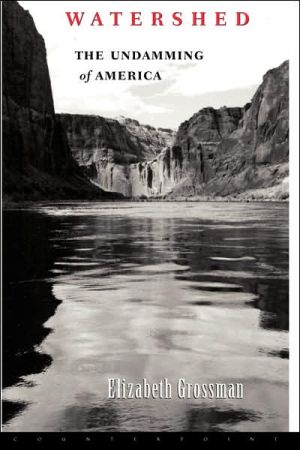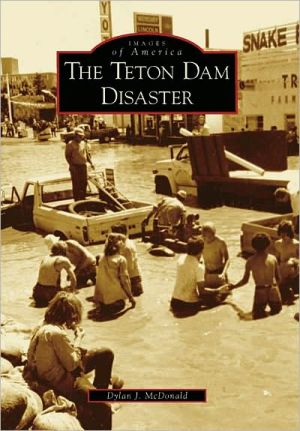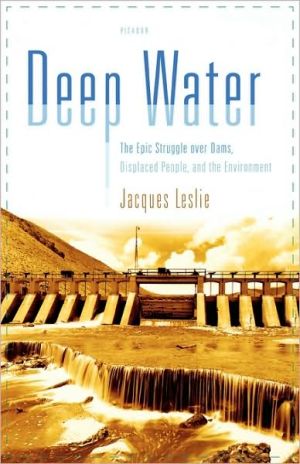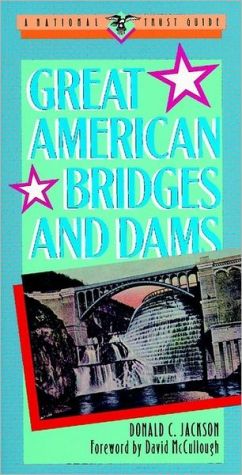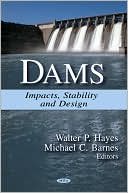Watershed: The Undamning of America
"Dams and diversions along America's rivers have transformed the country and in doing so created environmental problems whose resolution will, in many ways, determine how we live in the next century. There are over 75,000 dams in the country and almost no major river in the country remains undammed. But now, for the first time in our nation's history, the pace of dam removal has overtaken the pace of construction as communities across the country commit themselves to river restoration,...
Search in google:
A nature writer based in Portland, Oregon, Grossman surveys some of the many dams that have been removed in the US and the many communities that are considering restoring free flows to their rivers. The process is long, she warns, so many of the projects she describes are still in the works, or in some cases still in debate. Annotation c. Book News, Inc., Portland, OR Publishers Weekly Since before Edward Abbey protested Utah's Glenn Canyon Dam in his 1972 Monkey Wrench Gang, such attempts to make rivers work for us have been both controversial and problematic. In this whirlwind tour of dams across America, Grossman, a journalist based in Portland, Ore., persuasively illustrates why it's time for many of the 75,000 dams in the U.S. to come down. According to Grossman, dams were born of a driving need to manage the American landscape. More troubling, most were designed and built without a full understanding of how rivers function and without considering each dam's impact on its river system. As a result, rivers across the country are dying from our hydropower, irrigation and recreation needs. Dams affect a river's ecosystem from headwater to delta, throwing off the balance that fosters plant, insect and fish life along the way. The clearest example of damage is in dwindling fish populations: fish that depend on migration to spawn, such as steelhead and salmon, struggle to get up fish ladders, when they're incorporated in a dam at all, or need to be literally lifted over the dam. In California alone the steelhead population has dropped 90% since the 1950s. Grossman gives a national perspective to the current movement toward river reclamation by visiting about a dozen sites across the country; she reports on the conflicting perspectives that drive or resist reclamation, and she lays out the complex political and economic pressures. By considering each river as a continuous linked entity, Grossman offers a compelling update on a movement that could reshape the face of America. (July) Copyright 2002 Cahners Business Information.
PrologueIntroduction11Maine92North Carolina333Florida: The Crooked Creek and the Canal494Wisconsin675Glen Canyon Dam and the Colorado River916Montana1097California1238Oregon: Savage Rapids Dam and the Rogue River1399Washington: The Olympic Peninsula and the Elwha River Dams15310The Lower Snake River Dams16711Afterword199Notes205Bibliography211Acknowledgments222Index224
\ Publishers WeeklySince before Edward Abbey protested Utah's Glenn Canyon Dam in his 1972 Monkey Wrench Gang, such attempts to make rivers work for us have been both controversial and problematic. In this whirlwind tour of dams across America, Grossman, a journalist based in Portland, Ore., persuasively illustrates why it's time for many of the 75,000 dams in the U.S. to come down. According to Grossman, dams were born of a driving need to manage the American landscape. More troubling, most were designed and built without a full understanding of how rivers function and without considering each dam's impact on its river system. As a result, rivers across the country are dying from our hydropower, irrigation and recreation needs. Dams affect a river's ecosystem from headwater to delta, throwing off the balance that fosters plant, insect and fish life along the way. The clearest example of damage is in dwindling fish populations: fish that depend on migration to spawn, such as steelhead and salmon, struggle to get up fish ladders, when they're incorporated in a dam at all, or need to be literally lifted over the dam. In California alone the steelhead population has dropped 90% since the 1950s. Grossman gives a national perspective to the current movement toward river reclamation by visiting about a dozen sites across the country; she reports on the conflicting perspectives that drive or resist reclamation, and she lays out the complex political and economic pressures. By considering each river as a continuous linked entity, Grossman offers a compelling update on a movement that could reshape the face of America. (July) Copyright 2002 Cahners Business Information.\ \ \ \ \ Library JournalThe over 75,000 dams on the Army Corps of Engineers National Dam Inventory means there are virtually no major free-flowing rivers in the United States. But since 1998 more dams have been removed than have been built. Endangered species, tribal rights, private or public ownership, polluted silt, politics, removal costs this is just a short list of what must be addressed during the decommissioning of a dam. Grossman (coeditor, Shadow Cat: Encountering the American Mountain Lion) visited nine states where dams were either removed, such as Edwards Dam in Maine and three dams on the Neuse River in North Carolina, or where dams are still operating but have a contingency working on removal. There is much discussion of how people are affected by the dams and about community involvement, making the book of interest to the general reader, particularly for those located near a dam. She explains the original purpose of each dam, the benefits it originally provided, the changes it wrought, and the highly complex and interwoven multitude of issues involved in removal. Thoroughly researched, described, and presented, this enlightening and encouraging work is recommended for public and academic libraries. Nancy Moeckel, Miami Univ. Libs., Oxford, OH Copyright 2002 Cahners Business Information.\ \ \ From The CriticsA nature writer based in Portland, Oregon, Grossman surveys some of the many dams that have been removed in the US and the many communities that are considering restoring free flows to their rivers. The process is long, she warns, so many of the projects she describes are still in the works, or in some cases still in debate. Annotation c. Book News, Inc., Portland, OR\ \ \ \ \ BooknewsA nature writer based in Portland, Oregon, Grossman surveys some of the many dams that have been removed in the US and the many communities that are considering restoring free flows to their rivers. The process is long, she warns, so many of the projects she describes are still in the works, or in some cases still in debate. Annotation c. Book News, Inc., Portland, OR (booknews.com)\ \
